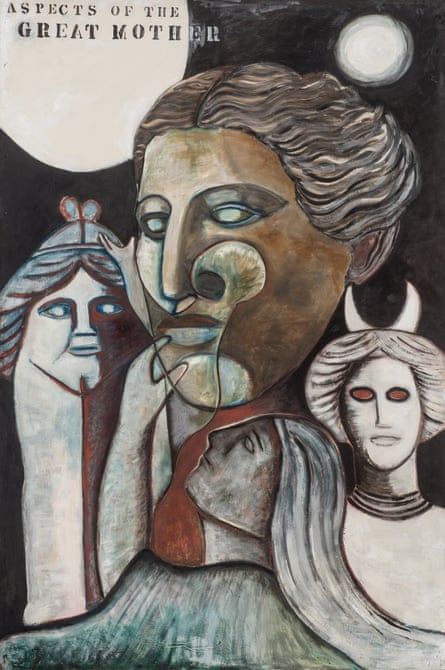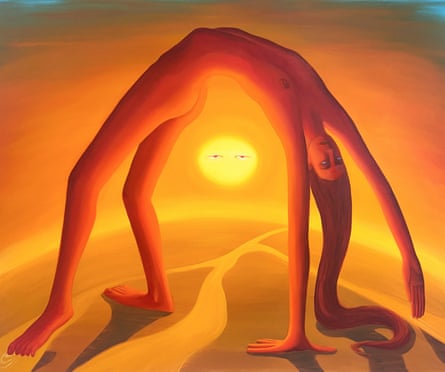When artist Stuart Pearson Wright was about five, he was woken by a spectral black dog standing over him. It growled and scratched the wall by his bed, leaving marks still visible the next morning. The incident stayed with him, and when he was older, Pearson Wright was fascinated by the myths of such “grims” (spectral dogs). In his new exhibition, he even creates portraits of them.
As an artist, he’s not alone in his interest in the paranormal. As recent exhibitions and auctions show, a new generation has been inspired by witchcraft, mysticism and spiritualism. The Horror Show at Somerset House, London, last year was a group show about ghosts, monsters and witches, including pieces by artist David Shrigley and Turner prize winner Tai Shani. In the summer, the Tate Modern showed Hilma af Klint and Piet Mondrian. Klint was clairvoyant and believed much of her work was created through automatic painting guided by spirits.

A major retrospective of Serbian artist Marina Abramović, currently running at the Royal Academy, showcases an artist whose fascination with shamanism and astrology informs her work. Next year brings a landmark show at Tate Modern dedicated to performance artist Yoko Ono, much of whose work is inspired by spirituality and mysticism.
Artist bones tan jones was one of the artists featured in the Somerset House exhibition and also had an installation at the Serpentine Gallery in 2022. They have just been announced as artist-in-residence at The Sustainable Institution in Europe. Their work has strong connections to paganism and spiritualism.
“As someone who feels deeply connected to spirit and earth, it’s important for me to view my artwork as craft and ritual,” says tan jones. “For me, every choice has meaning, every material is an ingredient in the cauldron that is the artwork.”
While emerging artists such as tan jones are gaining recognition, other art movements connected with spirituality and magic are being rediscovered, such as the surrealist movement – which had strong ties to magic, with many artists including ritual and symbols in their work.
This year at Christie’s auction house, a sale called Art of the Surreal featured an important collection amassed over 20 years by a Californian tech industry couple. The sale set records for works by Spanish painter Óscar Domínguez and artist/philosopher Wolfgang Paalen. Paalen’s piece Taches Solaires sold for £756,000. It shows magical figures seen in visions by the artist when he was a child.
At Lamb Gallery in London, Surrealism and Witchcraft opens this month, showcasing work by 11 female artists. Lucinda Bellm, Lamb’s founder and director, says surrealism is enduringly relevant. “The tumultuous first half of the 20th century set the stage for the emergence of surrealism,” says Bellm.
“Now that discussions around feminism, gender, and power dynamics are increasingly vital, it’s the perfect moment to celebrate female artists who draw inspiration from surrealism.”
She thinks witches are a potent symbol for female artists navigating a predominantly male art scene. “The witch offers a means to delve into complex themes of dreams, gender and sexuality.”

Environmentalism is another theme that plays strongly in art inspired by spirituality. This year brings renewed interest in the art of Monica Sjöö, a Swedish-born artist who described herself as a “radical anarcho/eco-feminist and goddess artist, writer and thinker involved in Earth spirituality”. A retrospective of her work is at Modern Art Oxford this month which moves to London next year.
Painter Pearson Wright is best known for his portraits of John Hurt and JK Rowling, which hang in the National Portrait Gallery, but his new show Miscellanalects – at Flowers Gallery in London – features his portraits of the Black Shuck, a spectral dog associated with East Anglia where he now lives.
Pearson Wright lives near Bungay, a Suffolk town associated with the Shuck right back to the 16th century. Bungay had the highest number of satanists per capita in the last national census.
Pearson Wright is fascinated by spiritual practices, such as werewolf shamanism, but he also says of the Black Shuck: “He could, of course, just be a big metaphor for something in the human psyche, and I think that’s interesting to contemplate too. He perhaps represents chaos, the Dionysian, the amoral natural world.
“Perhaps, most of all, he represents something within us, that part of ourselves which is unknowable and uncontrollable.
“Ultimately, we all fear the urges and passions that we have suppressed under a veneer of human culture.”
